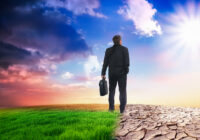What has prompted more than a million young individuals around the world to mobilize into a civil march for action on climate change?
“We have a climate emergency” was the overwhelming chant echoing through the streets of Waterloo, in Canada’s Ontario province, on March 15. An estimated 1.4 million young people, in Canada and all over the world, collectively skipped school that Friday to raise their voices against the biggest existential threat humanity faces. Civil disobedience protests like the Extinction Rebellion are bringing major cities like London to a standstill and shining a spotlight on just how harmful business-as-usual is for the planet.
This type of large-scale global youth mobilization is indicative of the palpable frustration about the lack of sustained action on tackling climate change that is now reverberating through the younger generations. Given the widespread coverage the global media now dedicate to climate change, the rest of the world is beginning to catch up on the various studies documenting our impact on the planet and the consequences we face if there is no change in the status quo.
It all depends on whether we choose to limit our global average temperature rise by even half a degree Celsius. A 2019 Intergovernmental Panel on Climate Change report outlines how even a 1.5-degree rise in global average temperatures above pre-industrial levels can be detrimental to global socio-economic stability.
Another interesting infographic by the World Resources Institute compares the rise in temperatures and its impact on humans and ecosystems. For example, at a rise of 1.5°C, extreme heat events increase by 14% (or once every five years), sea level rises by 0.40 meters, species extinction rises by 4%, crop yields reduce by 3%, and fisheries decline by 1.5 million tons. At 2˚C, these impacts become much more severe, namely 2.6 times worse for heat waves, bringing with it a 0.46-meter sea level rise, a doubled rate of species loss and fisheries decline, as well as 2.3 times lower crop yields.
Global March for Climate
What has prompted more than a million young individuals around the world to mobilize into a civil march for action on climate change? Simply put, for the younger generations climate impacts will increasingly get worse and disrupt a chance for a peaceful and stable life enjoyed by the previous generations. Climate protests like Fridays for Future and Extinction Rebellion believe that climate change is an emergency that needs to be prevented — now. For the young people of today, the stakes are high, as carbon budgets will get ever smaller with more extreme climate impacts. That is why young leaders like climate activist Greta Thunberg or US Congresswoman Alexandra Ocasio-Cortez are some of the leading voices when it comes to talking about climate change and its effects on the younger and future generations.
It is also due to protest movements such as these that 450 local governments and city councils around the world have declared a “climate emergency.” These local governments represent 40 million people from across Australia, Switzerland, United Kingdom, United States and Canada. Although it is a local win for most climate activists, according to The Climate Mobilization local governments are often the starting place for progress on bigger issues like minimum wage or civil rights. By declaring a climate emergency, such campaigns are a starting point for passing declarations on climate commitments, creating a transition pathway and mobilizing local policy changes.
As we can see from The Climate Mobilization data, a growing number of people in several countries is becoming concerned with climate change. For example, over 35% of Britain’s population and 28% of Canadians supported their local councils in declaring a climate emergency in their towns and cities.
It is especially interesting to see these local climate movements being led in places like the UK and Canada, where a rise of populist national and provincial governments — which do not necessarily support adaptation or mitigation efforts — might make for an interesting reaction to how people perceive climate change. As some studies suggest, higher levels of concern are a direct result of experiences with climate impacts like super hurricanes, unending wildfires or regular flooding. However, as a CBC article points out, experience may be a poor teacher, given how deeply entrenched climate change is as a partisan issue.
As demonstrated by the fraught debate on the subject in the United States, this partisan divide is not unique to Canada. However, analysis from The Climate Mobilization points out to an interesting finding that shows the highest number of responses from Canadian local councils — 379 as compared to 16 in the US or 91 in the UK — declaring a climate emergency. As various governments around the world go into their election cycles either this year or next, we will start to see if climate change translates into a real voting issue or not.
Intergenerational Equity Debate
However, the biggest part of the world’s population that faces impacts from climate change is the generation that may not even be of voting age yet. An interesting tool from the Carbon Brief combines data from emissions and population changes with climate modeling. By doing so, it can calculate the carbon budget of an average citizen over his or her lifetime in order to keep the temperature rise below 1.5˚C or 2˚C. If the world is to meet these targets to avoid catastrophic climate impacts, current and future generations will need to make drastic changes to their emission levels. Some of these include reduction in flying, meat consumption and the use of fossil fuels, among other things. And it gets worse with every generation: Children born now have a lifetime carbon budget that is 90% less than their grandparents.
The lack of climate action further impacts other socio-economic aspects like “employment, access to housing, availability of pensions” and the overall stability of our current lifestyles. This is a classic example of an intergenerational equity debate — one that environmentalists hear so often but rarely get to see in reality. Do we make the switch, or do we let future generations deal with the impacts as and when they happen?
To make it simple, as pointed out by the Extinction Rebellion infographic, the baby boomer generation (born between the mid-1940s to mid-1960s) and Generation X (born between the mid-1960s and early 1980s) is not likely to experience temperature anomalies. However, lifetime change for millennials (1980s-2000s) and Generation Z (mid-2000s) is going to look very different due to projected temperatures under different climate scenarios.
The problem of dealing with climate change or environmental degradation is not up to the future generations. It is a decision that we all, including baby boomers, Generation Xers and millennials, have to make in the present because it is about our families’ futures. We are still in the safe zone of climate impact, and this gives us the room to adapt our economies to being low-carbon, our consumptive habits to being sustainable, and our behavior to thinking long-term.
Although humans are more often reactive than proactive when it comes to change, it now becomes a question of whether we want to lead better lives than our parents, or an existence that is plagued of social, economic and climate emergencies. The widespread growth of these global youth-led climate movements is an important lesson to the older generations: Bottom-up, sustainable, green change is coming, whether you like it or not.
The views expressed in this article are the author’s own and do not necessarily reflect Fair Observer’s editorial policy.
Support Fair Observer
We rely on your support for our independence, diversity and quality.
For more than 10 years, Fair Observer has been free, fair and independent. No billionaire owns us, no advertisers control us. We are a reader-supported nonprofit. Unlike many other publications, we keep our content free for readers regardless of where they live or whether they can afford to pay. We have no paywalls and no ads.
In the post-truth era of fake news, echo chambers and filter bubbles, we publish a plurality of perspectives from around the world. Anyone can publish with us, but everyone goes through a rigorous editorial process. So, you get fact-checked, well-reasoned content instead of noise.
We publish 2,500+ voices from 90+ countries. We also conduct education and training programs
on subjects ranging from digital media and journalism to writing and critical thinking. This
doesn’t come cheap. Servers, editors, trainers and web developers cost
money.
Please consider supporting us on a regular basis as a recurring donor or a
sustaining member.
Will you support FO’s journalism?
We rely on your support for our independence, diversity and quality.







